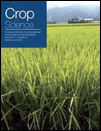Ver ítem
- xmlui.general.dspace_homeCentros Regionales y EEAsCentro Regional CórdobaEEA ManfrediArtículos científicosxmlui.ArtifactBrowser.ItemViewer.trail
- Inicio
- Centros Regionales y EEAs
- Centro Regional Córdoba
- EEA Manfredi
- Artículos científicos
- Ver ítem
Environmental Variation and Correlation of Seed Components in Nontransgenic Soybeans: Protein, Oil, Unsaturated Fatty Acids, Tocopherols, and Isoflavones
Resumen
The environment has a significant influence on the expression of traits contributing to soybean nutritional and/or industrial value. The aim of this study was to explore and describe the variability of nontransgenic soybean seed chemical components by investigating the environmental correlations among protein (Pr), oil (O), oleic (Ol), linoleic (La), and linolenic (Ln) acids, oleic to linolenic acid ratio (Ol:Ln) alpha- (AT), beta- (BT), gamma- (GT),
[ver mas...]
The environment has a significant influence on the expression of traits contributing to soybean nutritional and/or industrial value. The aim of this study was to explore and describe the variability of nontransgenic soybean seed chemical components by investigating the environmental correlations among protein (Pr), oil (O), oleic (Ol), linoleic (La), and linolenic (Ln) acids, oleic to linolenic acid ratio (Ol:Ln) alpha- (AT), beta- (BT), gamma- (GT), delta- (DT), and total tocopherols (TT) and total isoflavones (TI) by means of principal component analysis. We analyzed seeds from multienvironment trials involving 23 field trials grown in Argentina (24 to 38° S latitude). A wide range of variability was observed for Ol, Ln, Ol:Ln, AT, BT, and TI. The strongest environment-induced relationships found were the negative correlation between DT and AT and the positive correlation between DT and Ln. Increased Ol:Ln was negatively correlated with Ln. High values of DT, Ln, and Pr were associated with cool environments, TI content was greater in temperate to cool environments, and AT, O, and Ol:Ln were associated with warm environments. Warm environments would be suitable for obtaining products with higher O concentration of low oxidation capacity and greater vitamin E content. In turn, temperate to cool environments would be suitable for the production of soybean with higher TI, La, Ln, and TT content; in addition, these environments would favor seeds of higher Pr concentration.
[Cerrar]

Autor
Fuente
Crop Science 51 (2) : 800-809 (March 2011)
Fecha
2011-03-01
Editorial
Crop Science Society of America
ISSN
0011-183X
1435-0653 (online)
1435-0653 (online)
Formato
pdf
Tipo de documento
artículo
Palabras Claves
Derechos de acceso
Restringido
 Excepto donde se diga explicitamente, este item se publica bajo la siguiente descripción: Creative Commons Attribution-NonCommercial-ShareAlike 2.5 Unported (CC BY-NC-SA 2.5)
Excepto donde se diga explicitamente, este item se publica bajo la siguiente descripción: Creative Commons Attribution-NonCommercial-ShareAlike 2.5 Unported (CC BY-NC-SA 2.5)

